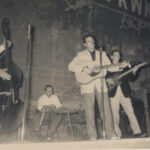In the realm of guitar effects, the equalizer (EQ) is an indispensable tool that goes far beyond simple tone adjustments. It’s about surgically sculpting your sound, eliminating unwanted frequencies, and enhancing the overall clarity and impact of your guitar in a mix. Understanding how to effectively use an EQ, especially within your effects chain, can be a game-changer for achieving professional and polished guitar tones.
Filtering Unwanted Frequencies for Clarity
One of the most crucial applications of a Guitar Effects Equalizer is filtering out frequencies that, while often inaudible, can negatively impact your overall sound. A prime example of this is the low-end rumble. You might not consciously hear frequencies below 50 Hz on your guitar, but these sub-bass frequencies are often present, especially in amplified settings or recordings. These inaudible frequencies can contribute to a muddy mix, consuming headroom and even making compressors work harder than necessary.
Using an EQ, particularly a parametric EQ like FabFilter Pro-Q (as mentioned in the original text, though any quality EQ plugin will suffice), allows you to visually identify and surgically remove these ultra-low frequencies. By applying a high-pass filter around 50-60 Hz, you can clean up the low end, resulting in a tighter, more focused guitar tone that sits better in the mix. This filtering process isn’t about drastically altering your perceived guitar tone; it’s about removing unnecessary sonic clutter and optimizing your signal for further processing and mixing.
Dynamic EQ for Problematic Frequencies in Acoustic Guitar
The versatility of a guitar effects equalizer truly shines when addressing specific frequency issues, particularly with acoustic guitars. Close-miking acoustic guitars, a common recording technique, can often lead to an exaggerated low-end response, especially on certain notes. This phenomenon can result in a “boomy” or “woofy” sound that detracts from the natural warmth and clarity of the instrument. While a standard high-pass filter might seem like a solution, it can sometimes thin out the desired richness of the acoustic guitar tone.
This is where dynamic EQ becomes invaluable. A dynamic EQ allows you to target and attenuate problematic frequencies only when they become overly prominent. For instance, if specific notes on your acoustic guitar exhibit an undesirable low-frequency resonance, a dynamic EQ can be set to automatically reduce those frequencies whenever they exceed a certain threshold. This intelligent frequency control effectively tames the “woof” without permanently removing the low-end warmth of the guitar, resulting in a more balanced and rounded acoustic tone.
Guitar Bus EQ for Efficient Tone Shaping Across Multiple Tracks
For guitarists layering multiple parts or creating complex arrangements, bus mixing and bus EQ can significantly streamline the mixing process and enhance sonic cohesion. Think of a bus as a subgroup – in this case, a “guitar bus” – where you route multiple individual guitar tracks. This could be double-tracked rhythm guitars, harmonizing lead lines, or any collection of guitar parts that share a similar sonic role.
Applying EQ to this guitar bus offers several advantages. Firstly, it’s incredibly efficient in terms of DSP usage, especially in digital audio workstations. Instead of applying EQ individually to each guitar track, you can shape the overall tone of the entire guitar subgroup with a single EQ instance on the bus. Secondly, bus EQ allows for broad-stroke tonal adjustments that affect all guitars within the bus in a musically cohesive way. For example, if your entire guitar section sounds slightly dull, you can use a parallel EQ like the UBK Clariphonic (as referenced in the original article) on the guitar bus to subtly lift the high frequencies, adding “air” and “silkiness” to the collective guitar tone without having to meticulously tweak each individual track.
Conclusion
Mastering the guitar effects equalizer is about more than just adjusting knobs; it’s about understanding frequencies, identifying sonic problems, and creatively shaping your guitar tone for optimal clarity, impact, and mix integration. Whether it’s surgically filtering unwanted low-end rumble, dynamically taming resonant frequencies, or efficiently shaping the tone of entire guitar subgroups with bus EQ, the equalizer is an essential tool in any guitarist’s sonic arsenal. Experiment with different EQ techniques and discover how this powerful effect can elevate your guitar playing and production to new levels.

